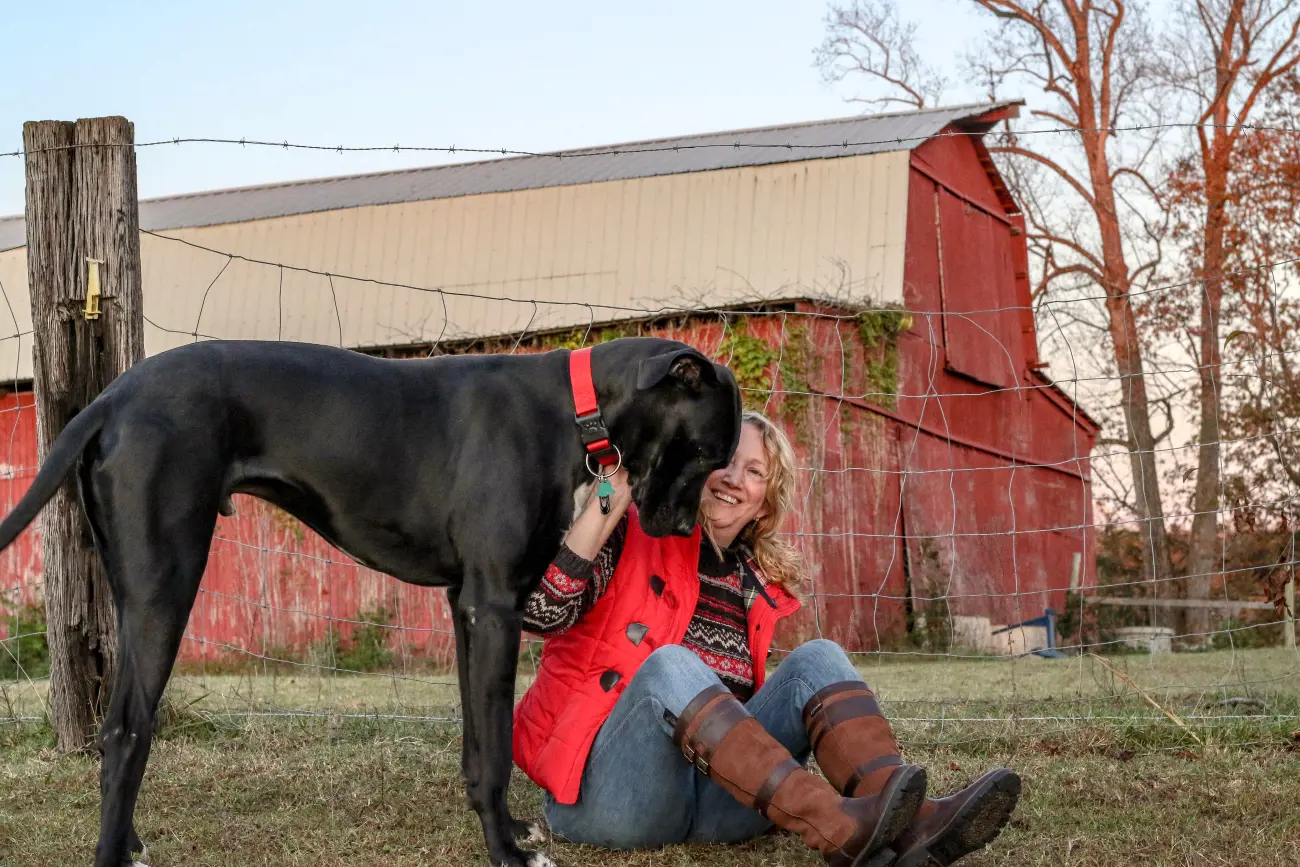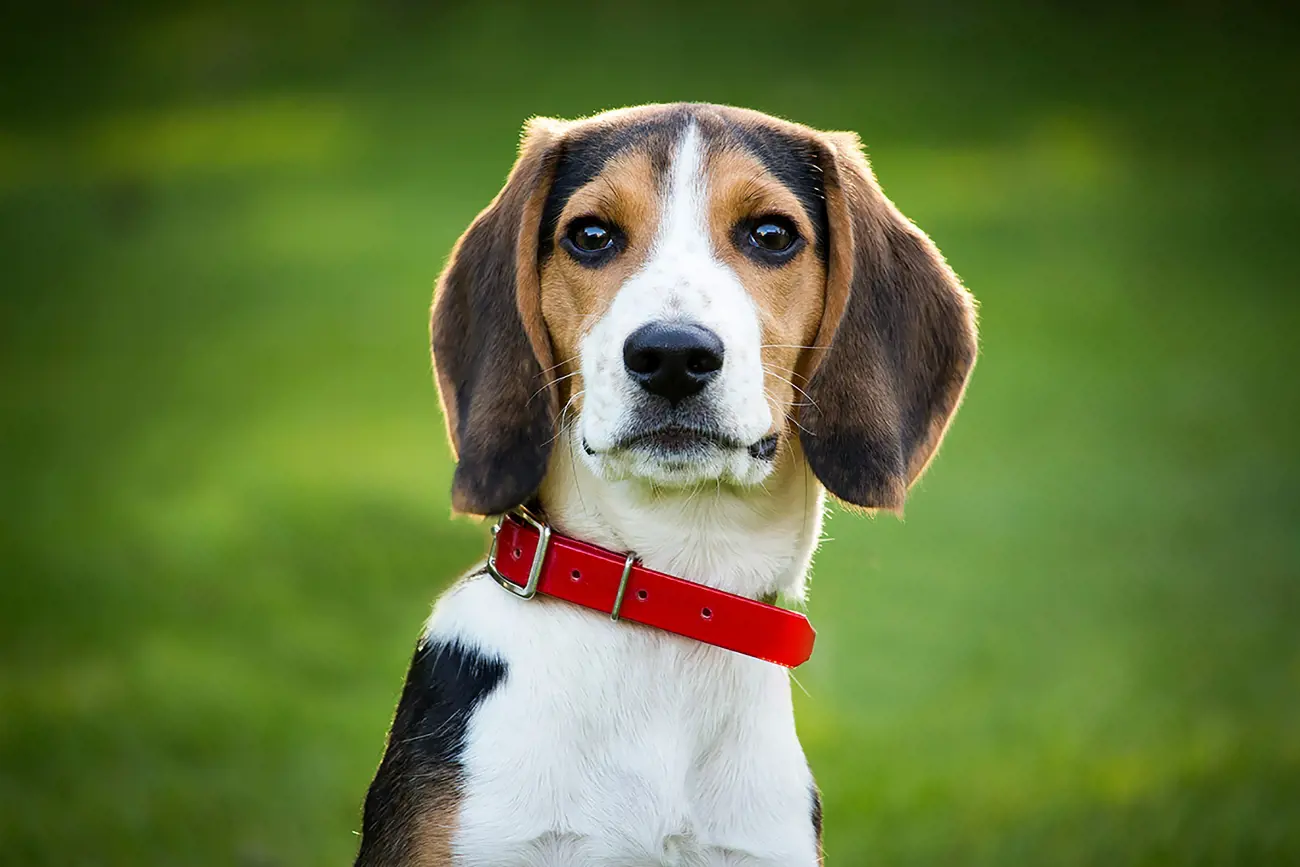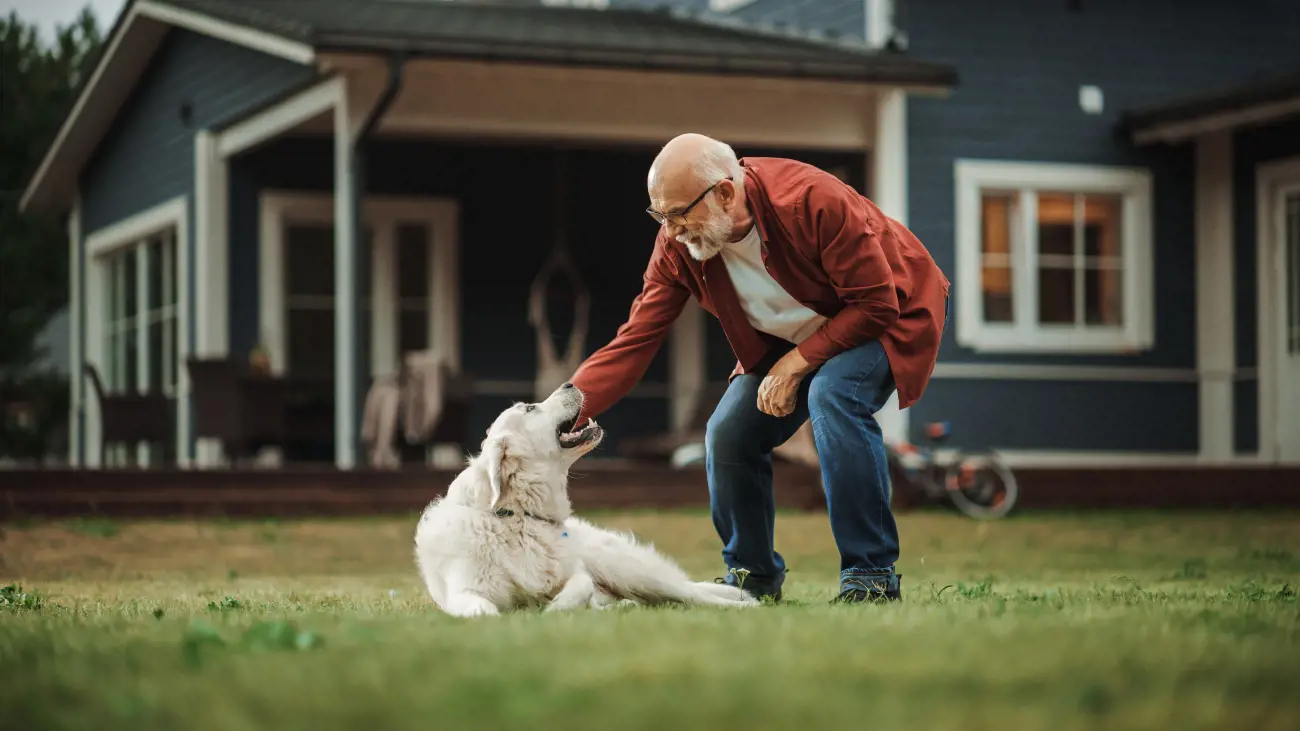What's the best way to pick up your dog?
23rd December, 2021

Perhaps the first thing to say about picking up a dog is that it's not something you should need to do very often.
Dogs by their nature are extremely active, and will much prefer to be bounding along by your side, getting their daily quota of exercise and engaging their senses of sight, sound and smell. This will always be far preferable to most dogs than being hauled off the floor and into your arms.
However, there will be occasions when you need to lift your beloved pet. You may be hoisting them onto an examination table at the vet, for example, for some procedure or examination (which we hope will be covered by your insurance). Or they might find themselves in an awkward situation, and need your help getting out of it. They may just need a little help with the path ahead, whether the going has got very muddy or their little legs just won't carry them any further. They may even be carrying an injury, and struggling to keep up.
Now, you're probably thinking that picking up a dog is the most basic thing in the world. And yes, it shouldn't be too challenging. However, there are some key things to get right, and others to avoid, in order to make the lifting as calm and pleasant as possible for your dog – and to ward off the possibilities of any strains or injuries, or even mental ill effects.
So, how do you do it properly?

Dog lifting: dos and don'ts
When it comes to lifting your dog it's a good idea, first of all, to give them some kind of advance clue as to what's about to happen. Dogs are most used to getting around under their own steam and having their four feet planted on the floor, and it'll come as a shock to find themselves suddenly scooped up in the air. So prepare them for the lift before you make the move. We'll go into more detail on this later in the article.
When it comes to the lift itself, there are certain techniques that work best. In the case of small dogs, it's best to put one arm under your dog's chest, and the hand from that arm between their front legs. As you lift them, your other hand should tuck their legs or backside up against your own body, so that they're properly supported.
Alternatively, you can scoop one arm under their front legs and use it to lift them, forklift-style, while the other hand supports their feet – and again, bring them into your body for support.
In the case of bigger dogs, the best lifting style is to have one arm around the front of their chest, under the neck – and the other around their back legs, beneath the rump. Press your dog’s body against your chest and lift, making sure that they are well-supported and feel safe.
Be sure to bend your knees and rise straight upwards, as much as possible. This might sound like an instruction aimed at protecting your back muscles: however, while that may be a factor with the biggest dogs, it's more about being attentive to your dog's wellbeing. The less you need to bend at the waist, the more secure your dog will feel in your arms.
Things to avoid here include lifting your dog by the scruff of the neck – or by the front legs, which can strain ligaments. Also, never lift a dog up by their armpits, as this can be painful to them and will definitely create some lasting negative associations with being picked up.
How often do you actually need to pick up your dog?
Given that your dog is rarely likely to enjoy being lifted (even if you use some of the techniques and incentives we'll discuss here), it's a good idea to keep the experience to a minimum.
Dogs will often object noisily to being picked up – they may dash away from you, their body may tense, or they may growl, snap or snarl. There are even cases of dogs inflicting serious bites on their owners, although this is usually after one or two prior warnings from the dog that they’re not keen on what is happening!
Smaller dogs are, of course, more susceptible to being unceremoniously snatched up and lifted off the ground. This can be particularly common in families: children will love to pick up smaller animals, and indeed this can form a vital part of their bonding process – a genuinely beneficial experience for everyone involved.
However, even larger dogs will find themselves picked up and enfolded in someone's arms from time to time. And, as we examined above, there are cases when the lift needs to happen. But outside of these occasions, it's best to avoid lifting your dog as much as possible.
Alternatives to lifting
There are quite a few other options when it comes to getting your dog where you need them to be. Why not try some of these?
-
If you simply need to get them up onto your bed, the sofa, or the boot of the car for a walk, it's better – if they are able – for your dog to jump up to these places, rather than being lifted. If they can't manage the leap, a ramp may be a useful investment.
-
Small dogs may prefer to jump into their travelling case, or something similar such as a laundry basket, and be carried that way.
-
Again, with small dogs, why not teach them to jump into your lap while you’re seated? Then, you can stand up while holding them, making sure that they are well supported against your chest.
-
Some smaller dogs may prefer to be carried in a backpack or chest harness.
-
More athletic dogs can be taught to jump into your arms.
-
When it comes to getting your dog up onto the examination table at the vet's, the lifting manoeuvre may not always be necessary. Find out if your vet is able to lower the examination table enough for your dog to get up under their own steam. Alternatively they may have a harness that can help take their weight.

What are the signs that a dog doesn't like being lifted or carried?
Your dog may object to being lifted simply because it feels unnatural. They just want to be planted firmly on the ground, able to go where they want and follow wherever their nose is leading them! However, there are also occasions when pain can be a factor in your dog objecting to being lifted.
For example, if they are growling or clearly trying to avoid being lifted, this may indicate some existing pain that is aggravated by the lift. In this case, we'd recommend asking your vet – at your next check-up – to carry out a physical examination, just to check whether there's a problem.
For example, arthritis, a spinal misalignment, or a strain or sprain will all make pickups a more than usually negative experience for your pup. Their complaints should alert you to keep lifting to an absolute minimum. Your vet will also advise on how to minimise your dog's discomfort in general. There may be, in the case of arthritis or a similar condition, a course of treatment or medication to follow. With luck, some of the costs for this will be borne by your canine's insurance policy.
There might even be something in your dog's past that makes them object to being lifted. For example, there may have been a previous occasion when they were picked up, and something unpleasant or painful occurred. Your dog may be expecting something similar each time you approach them to pick them up now.
In this case, perform the procedure as gently, and with as much warning, as possible. Perhaps you can create more positive associations by offering them a treat or their favourite walk afterwards?
Can you train your dog to accept being lifted?
Yes – you can definitely create some happier associations around being lifted, and even allow your beloved pet to have some choice in how the process is carried out.
For example, you can segment the picking-up process into small stages, and make sure your dog becomes happy and familiar with each one before moving onto the next. You might want to reward them with a suitable, low-calorie treat when each stage is accomplished.
We'd recommend starting out slowly and gently. Reach out towards your dog, and offer them a treat while doing so. Repeat this little pairing until your dog actively looks for the treat when it sees you reaching out. After this, you can touch them – and feed them the treat. You can then build up the process in this way, each time getting a little closer to actually lifting them, and making sure that each stage has some happy associations.
When you are ready to carry out the lift, it's a good idea to add in a spoken cue. You might, for example, use the command "Up". Of course, that command may already mean something to your dog – such as "jump up". In this case, try a different word or gesture. "Lift" might do the job!
As you use this cue, you can start to put some very gentle upward pressure onto their body – followed by another treat. As you repeat this process, watch to see if your dog is anticipating your actions. They may move into your open hands when you lower them ready for the lift, for example, and/or boost themselves up ready when they see or hear the "Lift" cue.
Once these responses are happening all the time, your dog has made the connection and is willingly helping in the process. And that should be your aim, with lifting and with anything else that you want to achieve with your pet: they should be happy, willing participants in whatever you are doing together.
Now you have established this procedure, you need to stay committed to it. Each time you say "Lift!", look out for a signal that your pup is ready and happy to be picked up. Once you get that signal, go ahead.
However, if you don't see the sign, stop: they are either not ready to be picked up, or not comfortable in some way. Wait, take up a new position if appropriate, and try again – never force your pet into something they don’t want to do.

Be patient and gentle – and use alternatives where possible
Some dogs will flatly refuse to be picked up. In this case, you should always fall back on one of the alternatives to lifting that we discussed above. And the lifting itself should only be done in an absolute emergency – if your pup is injured, for example, and must be rushed to the vets.
In these cases, do the pick-up as gently and carefully as you can, and follow the steps we listed at the top of the article. Later, you can go back and try to refresh the training.
Pet insurance from Purely Pets
You're reading this because you care deeply about your dog's long-term health, wellbeing and happiness – and you'll do all you can to give your beloved pet the best life possible.
A key part of that loving care is to provide them with some specialist dog insurance, which can help you to prepare financially for whatever medical costs may lie ahead.
You can choose from our 15 different cover levels of award-winning lifetime dog insurance, to provide your pup with the care they deserve.
Cover benefits include vets’ fees up to £15,000 and an excess starting at just £60, both depending on the policy level you choose. Elsewhere, our free 24-Hour Vet Helpline can help with all your dog-related questions and concerns.
Contact us today to arrange a quick quote for dog insurance.
Helpful Pages
Recent Posts

Why do Great Danes bury their heads?
12/03/25
Find out more about Beagles
28/02/25Pet Insurance Quote
- 98% claims paid *
- Claims paid directly to vets
- 24/7 vet video consultations
- Interest free monthly payments


